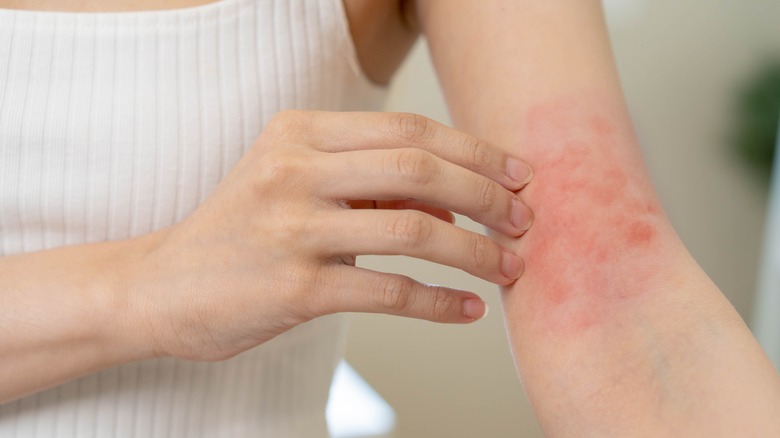Purpura Vs Bruise: What's The Difference?
When you notice a spot on your skin that is noticeably different than the surrounding area, it can be alarming. Skin discolorations affect many people and can be caused by a variety of factors, per Healthline, and the appearance and severity can vary widely depending on the cause or type. Common types of discoloration include birthmarks and skin disorders such as vitiligo or liver spots.
Skin discoloration may by caused by genetics, age, exposure to the sun, and medication side effects. Discolored skin can also indicate an underlying medical issue. Purpura, for example, are spots or patches that can emerge on the skin, mouth, and throat, and are caused by various medical conditions, says the Cleveland Clinic. Purpuras are sometimes confused for bruises or contusions, which usually occur when small blood vessels beneath the skin break and leak blood into the surrounding tissues (via the Cleveland Clinic). Although both conditions occur due to bleeding under the skin, they differ in appearance and cause.
What do bruises look like?
According to the Cleveland Clinic, bruises are typically caused by injury or trauma, such as a blow, fall, or bump. Bruises can vary in shape, color, and size, depending on the cause and location of the body. Initially, a bruise may appear red or purple, reflecting the presence of oxygenated blood — over time, as the bruise heals, it may change color to blue or even black as the blood in the affected area breaks down, says Medical News Today. By day 14, the bruise may appear as a yellowish-brown or light brown.
Eventually, the bruise will fade and disappear as the body completes the healing process. In most cases, bruises do not require any specific treatment and will heal independently. If needed, you can apply an ice pack or heating pad to the affected area. However, severe or persistent bruises may require medical attention to ensure proper healing and to rule out any underlying medical conditions or serious injuries.
How does a purpura differ from a bruise?
While bruises are typically caused by trauma, a purpura rash is usually a symptom of an underlying medical issue, per the Cleveland Clinic. According to Medical News Today, a purpura rash doesn't have a broad color and size range like bruises. They often appear as red, brown, or red blood spots on the skin and have a size range of 4–10 millimeters in diameter. They also come in different types: thrombocytopenic purpura, non-thrombocytopenic purpura, and solar purpura.
Thrombocytopenic purpura is caused by decreased platelet count, which can lead to bleeding and bruising — this kind of purpura may indicate a blood clotting issue. Non-thrombocytopenic purpura does not involve a decrease in platelet count and often has other causes, including vitamin C deficiency, inflammation, and blood clots (via the Cleveland Clinic). Other general causes of purpura include medication side effects, infections, or underlying medical conditions like autoimmune disorders, blood infections, or vascular disorders. Some examples of medical conditions that can cause a purpura rash include immune thrombocytopenia, vasculitis, and leukemia. Solar purpura, as the name suggests, are caused by damage from the sun over time, and is most often seen in older people.
In many cases, purpura will resolve in its own. Treatment typically focuses on controlling or curing the underlying medical condition that caused the purpura.



